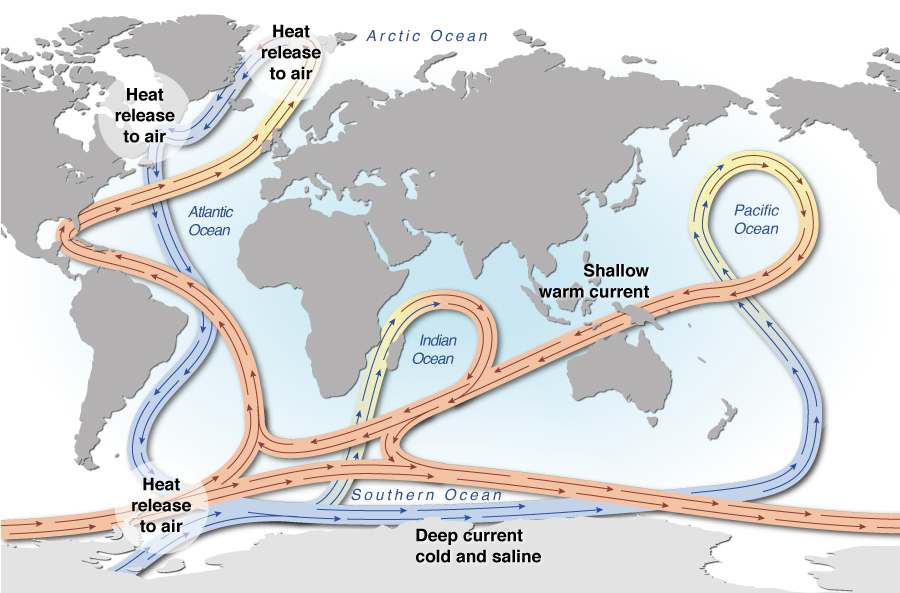Well, actually, everything! What goes on in our atmosphere is inextricably linked to what is going on in our oceans. Where do we begin?
Normally you might expect this discussion to start with our Sun, the continual provider of (almost) all our energy. It is, of course, true that the irregular distribution of heat around our planet is mainly due to the fact that the Earth is tilted, currently around 23.4° from the vertical, giving rise to our seasons via uneven solar heating at our surface.
The ‘tilt’, or obliquity to give its proper name, is important, for it not only gives us our seasons throughout each year, it also heats our oceans unevenly. Unlike air, that quickly moves from place to place as ‘the wind’, the oceans move much more slowly. Seas have a high specific heat capacity. That is to say; cold waters take a long time to warm up and, conversely, warmer waters take a long time to give up their heat.
This property allows a massive heat transport system to operate around the globe, moving warmer waters polewards from equatorial regions and, similarly, colder waters from the poles towards the equator. The driver for this oceanic circulation, the Thermohaline Conveyor, is still, essentially, the Sun. The ‘big engine’ actually starts on our doorstep, in the North Atlantic Ocean.
As cold fresh water runs off into the Arctic Ocean from rivers in, for example, Siberia and northern Canada, together with glacial and ice sheet meltwater, it starts its flow southwards via the only route available: along the Greenland coast and through the Denmark Straits where it meets the Labrador Current. Together, these cold waters sink below the warmer and more saline (salty) Atlantic surface waters where they flow very, very slowly along the seabed.
In the meantime, very warm waters from the Gulf of Mexico – the Gulf Stream – are drifting relatively quickly polewards along the North American eastern seaboard where they warm the air directly above, and in contact with them, providing northern Europe, and the U.K. in particular, with our uniquely temperate climate.

Source: Hugo Ahlenius, UNEP/GRID-Arendal, https://www.grida.no/resources/5228
The cold bottom waters move around the globe and eventually rise to the surface again in the Pacific and Indian Ocean equatorial regions where they are heated again and travel around as surface waters, once again moving heat around Earth and helping towards maintaining a global temperature equilibrium. It takes something like 1000 years for the waters to complete a full trip!
A number of deep ocean currents and counter currents flow around the planet but we need not concern ourselves with those here.
Back to the weather
While the surface waters are doing the rounds, they are continually in contact with the air above them. Bear in mind that air and water are both fluids, just different densities. One is present as a gas, the other as a liquid, but the interface between them is not quite so clear. Mixing takes place.
Imagine a choppy sea. The wave tops break into water droplets (spindrift) – more about water droplets later. They become atomised and/or ionised. A chemical exchange takes place (for further information, see Carbon Cycle, Nitrogen Cycle, Sulphur Cycle, and others). Depending on the water itself, an energy exchange also takes place – warm water heats the air, cool water draws heat from the air. The modified air also changes its relative humidity, how much moisture it contains. This directly decides how clouds will form higher up in the troposphere. So the oceans will change the air temperature and relative humidity and, hey presto, the weather changes at the behest of the oceans.
Is that it then?
Not quite. Every water droplet in the atmosphere has to form around a microscopic bit of dust or dirt, called a ‘condensation nucleus’. Water will not form a droplet on its own, it has to adhere to something by surface tension. This is why windows, bathroom mirrors and your glasses steam up. If they were perfectly clean, the water couldn’t form droplets. It’s the ‘dirt’ on the surfaces that allows the droplets to form. Be careful how you explain this fact when you get home!
So, how big is the dust/dirt? Well, let us get this into context. Each water droplet contains a condensation nucleus and it takes about million cloud droplets to form a single raindrop. (Brief pause while you take that in). You can now imagine just how tiny they are, and imagine how many are required for a big rain storm.
Where do the specks come from? Mostly sea salt from the above explanation, but also sand storms, dust storms, windblown soil, cosmic dust and air pollution contribute. A major supplier is volcanism. All that dust thrown into the troposphere and even into the stratosphere, where it’s carried around the globe by the jet streams. But there is an even greater source of volcanism than that which you see on Earth’s surface.
On the floor of the major oceans, most notably the Pacific and Atlantic, the seabed is moving apart to form new crust. Here, volcanism is rife and some of ‘ejecta’ finds its way to the surface and, ultimately into the air to form water droplets. Hence, we have now seen how our weather can be influenced by oceanic events. It actually goes much further than this short piece can explain; it controls climate, too.
One parting note, I mentioned that without volcanoes, we wouldn’t be here. Let me briefly explain. Humans (and many other life forms) need water to exist. In fact, we are predominantly made up of the stuff. Water can only get to us recycled as rain. Raindrops can only exist as a coalescence of water droplets. Water droplets only exist because of condensation nuclei. A major source of condensation nuclei is volcanoes.
Hence, no volcanoes, no surface life as we know it! Q.E.D.
Download PDF
If you wish to save, or print, this article please use this pdf version »
Learning resource
We have created learning notes to assist students and educators to further investigate the topics covered in this article. You can download the learning resource here »


